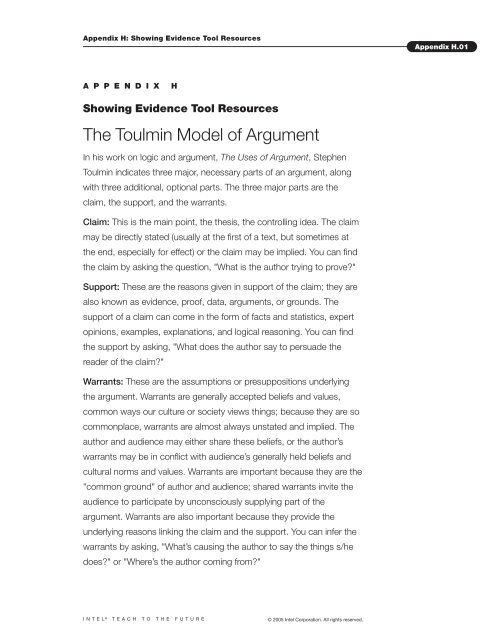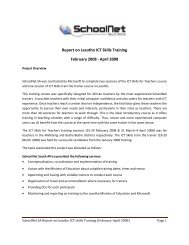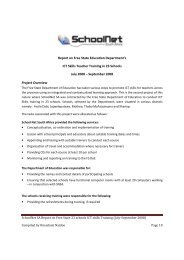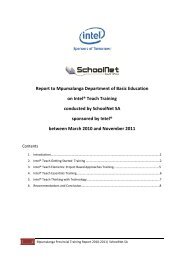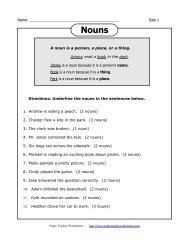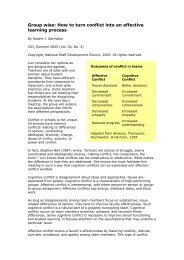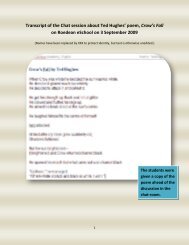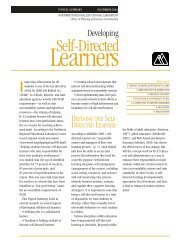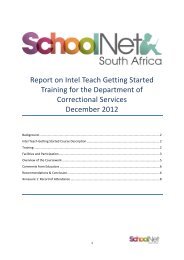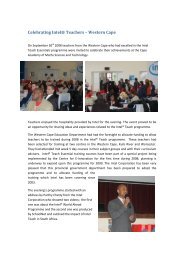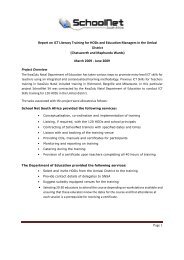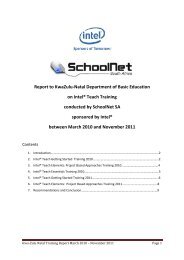The Toulmin Model of Argument
The Toulmin Model of Argument
The Toulmin Model of Argument
Create successful ePaper yourself
Turn your PDF publications into a flip-book with our unique Google optimized e-Paper software.
Appendix H: Showing Evidence Tool ResourcesAppendix H.01A P P E N D I X HShowing Evidence Tool Resources<strong>The</strong> <strong>Toulmin</strong> <strong>Model</strong> <strong>of</strong> <strong>Argument</strong>In his work on logic and argument, <strong>The</strong> Uses <strong>of</strong> <strong>Argument</strong>, Stephen<strong>Toulmin</strong> indicates three major, necessary parts <strong>of</strong> an argument, alongwith three additional, optional parts. <strong>The</strong> three major parts are theclaim, the support, and the warrants.Claim: This is the main point, the thesis, the controlling idea. <strong>The</strong> claimmay be directly stated (usually at the first <strong>of</strong> a text, but sometimes atthe end, especially for effect) or the claim may be implied. You can findthe claim by asking the question, "What is the author trying to prove?"Support: <strong>The</strong>se are the reasons given in support <strong>of</strong> the claim; they arealso known as evidence, pro<strong>of</strong>, data, arguments, or grounds. <strong>The</strong>support <strong>of</strong> a claim can come in the form <strong>of</strong> facts and statistics, expertopinions, examples, explanations, and logical reasoning. You can findthe support by asking, "What does the author say to persuade thereader <strong>of</strong> the claim?"Warrants: <strong>The</strong>se are the assumptions or presuppositions underlyingthe argument. Warrants are generally accepted beliefs and values,common ways our culture or society views things; because they are socommonplace, warrants are almost always unstated and implied. <strong>The</strong>author and audience may either share these beliefs, or the author’swarrants may be in conflict with audience’s generally held beliefs andcultural norms and values. Warrants are important because they are the"common ground" <strong>of</strong> author and audience; shared warrants invite theaudience to participate by unconsciously supplying part <strong>of</strong> theargument. Warrants are also important because they provide theunderlying reasons linking the claim and the support. You can infer thewarrants by asking, "What’s causing the author to say the things s/hedoes?" or "Where’s the author coming from?"INTEL ®TEACH TO THE FUTURE© 2005 Intel Corporation. All rights reserved.
Appendix H.02Appendix H: Showing Evidence Tool ResourcesHere’s a visual representation and an example:ClaimSupportUniversities should reinstateAffirmative action providesaffirmative action admissionsequal access to educationpolicies.for all ethnic groups.WarrantEquality <strong>of</strong> access is abasic American value.In this example, the claim that universities should reinstate affirmativeaction polices is supported by the reason that affirmative actionprovides equal access for all ethnic groups. It’s generally acknowledgedby most Americans that equality <strong>of</strong> access is a basic American value.<strong>The</strong>re are three additional parts to <strong>Toulmin</strong>’s model <strong>of</strong> argument. Notevery one <strong>of</strong> these is used in every argument, but only as need arises.Qualifiers: Because argument is about probability and possibility, notabout certainty, you should not use superlatives like all, every,absolutely or never, none, no one. Instead you may need to qualify(tone down) your claim with expressions like many, many times, someor rarely, few, possibly.Rebuttal: When making an argument, you must take into considerationother conflicting viewpoints and deal with them fairly. You need toanswer questions and objections raised in the minds <strong>of</strong> the audience; ifyou fail to do so, your own argument will be weakened and subject toattack and counter-argument. Sometimes rebuttal will be directed toopposing claims; other times rebuttal will be directed at alternativeinterpretations <strong>of</strong> evidence or new evidence.Backing: Sometimes the warrant itself needs evidence to support it, tomake it more believable, to further "back up" the argument.<strong>The</strong>se additional elements <strong>of</strong> argument may be added to our visualrepresentation as follows:(Qualifier) ClaimSupport(Rebuttal) Warrant [Rebuttal](Backing)© 2005 Intel Corporation. All rights reserved.INTEL ®TEACH TO THE FUTURE
Appendix H: Showing Evidence Tool ResourcesAppendix H.03Qualifier: If a university does not have a diverse student bodyClaim: ...it should use affirmative action admissions policies.Support: Affirmative action policies provide equal access to educationfor all ethnic groups.Warrant: Equality <strong>of</strong> access is a basic American value.Backing: Equality before the law is a fundamental right <strong>of</strong> allAmericans.Rebuttal: Affirmative action policies do not result in "reversediscrimination" because they are only part <strong>of</strong> a process that attempts toensure fairness in college admissions.Five Categories <strong>of</strong> Claims<strong>Argument</strong>ative essays are based on a claim, which almost always fallsinto one <strong>of</strong> the five following categories.1. Claims <strong>of</strong> fact. Is it real? Is it a fact? Did it really happen? Is it true?Does it exist?Examples: Global warming is occurring. Women are just as effective asmen in combat. Affirmative action undermines individual achievement.Immigrants are taking away jobs from Americans who need work.2. Claims <strong>of</strong> definition. What is it? What is it like? How should it beclassified? How can it be defined? How do we interpret it? Does itsmeaning shift in particular contexts?Examples: Alcoholism is a disease, not a vice. We need to define theterm family before we can talk about family values. Date rape is aviolent crime. <strong>The</strong> death penalty constitutes "cruel and unusualpunishment."3. Claims <strong>of</strong> cause. How did this happen? What caused it? What ledup to this? What are its effects? What will this produce?Examples: <strong>The</strong> introduction <strong>of</strong> the computer into university writingclasses has enhanced student writing ability. <strong>The</strong> popularity <strong>of</strong> theInternet has led to a rise in plagiarism amongst students. <strong>The</strong> economicboom <strong>of</strong> the 1990s was due in large part to the skillful leadership <strong>of</strong> theINTEL ®TEACH TO THE FUTURE© 2005 Intel Corporation. All rights reserved.
Appendix H.04Appendix H: Showing Evidence Tool Resourcesexecutive branch.4. Claims <strong>of</strong> value. Is it good or bad? Beneficial or harmful? Moral orimmoral? Who says so? What do these people value? What valuesystem will be used to judge?Examples: Doctor-assisted suicide is immoral. Violent computer gamesare detrimental to children’s social development. <strong>The</strong> Simpsons is not abad show for young people to watch. Dancing is good, clean fun.5. Claims <strong>of</strong> policy. What should we do? How are we to act? Whatpolicy should we take? What course <strong>of</strong> action should we take to solvethis problem?Examples: We should spend less on the prison systems and more onearly intervention programs. Welfare programs should not bedismantled. <strong>The</strong> state <strong>of</strong> Oklahoma ought to begin to issue vouchers forparents to use to fund their children’s education. Every person in theUnited States should have access to federally-funded health insurance.Adapted from Nancy Wood’s Perspectives on <strong>Argument</strong>, 2nd ed. (pp.161-172)Just about any given topic can lend itself to be stated as one <strong>of</strong> the fivetypes <strong>of</strong> claims. For example, the topic <strong>of</strong> gun control could beapproached from any <strong>of</strong> the five different types <strong>of</strong> claims:Claim <strong>of</strong> Fact: <strong>The</strong>re are serious restrictions on our Constitutional rightto bear arms. (This essay will give facts, examples, and statisticsrelating to laws and policies that restrict the sale and use <strong>of</strong> firearms.)Claim <strong>of</strong> Definition: Laws governing the sale <strong>of</strong> firearms such asassault weapons and handguns do not constitute an infringement onour right to bear arms. (This essay will focus on the Bill <strong>of</strong> Rights and itsclause about the right to bear arms. It will argue for a particulardefinition that excludes the writing <strong>of</strong> laws that relate to ownership <strong>of</strong>firearms.)Claim <strong>of</strong> Cause: Tougher laws governing the sale <strong>of</strong> handguns wouldmean a decrease in the number <strong>of</strong> homicides each year. (This essay willseek to establish a link between difficulty in obtaining a handgun and adrop in the homicide rate. It will use statistics, facts, and analogies from© 2005 Intel Corporation. All rights reserved.INTEL ®TEACH TO THE FUTURE
Appendix H: Showing Evidence Tool ResourcesAppendix H.05other places where similar things have been done.)Claim <strong>of</strong> Value: <strong>The</strong> right to bear arms is still an important civil right inthe United States. (This essay will appeal to people’s sense <strong>of</strong> the value<strong>of</strong> gun ownership. It will probably appeal to authorities, such as theConstitution, to history, and to long-held customs.)Claim <strong>of</strong> Policy: <strong>The</strong> sale <strong>of</strong> assault weapons in the United Statesshould be banned. (This essay will use a variety <strong>of</strong> motivational appealsand value pro<strong>of</strong>s, analogies, facts and statistics, cause and effectarguments, and appeals to authorities to prove that this is a favorablecourse <strong>of</strong> action.)Source: Swadley, Charles. “<strong>Argument</strong>ation.” Retrieved fromhttp://students.ou.edu/S/Charles.R.Swadley-1/argumentation.htmUsed with permission.Who is <strong>Toulmin</strong>?Stephen <strong>Toulmin</strong> was born in London, England, on March 25, 1922. Hereceived a Bachelor <strong>of</strong> Arts degree in mathematics and physics fromKing's College in 1942. He earned a Master <strong>of</strong> Arts degree in 1947 anda Doctorate <strong>of</strong> Philosophy degree in 1948 from Cambridge University,but he has spent most his life teaching at universities in the UnitedStates.<strong>Toulmin</strong> published Uses <strong>of</strong> <strong>Argument</strong> in 1958. Philosophers in Englandwere critical <strong>of</strong> the book as they were more interested in the study <strong>of</strong>formal logic; so, at the time, the book was received poorly in England.However, it was well received in the United States within thedepartments <strong>of</strong> Speech and English, or at Schools <strong>of</strong> Law, because <strong>of</strong>its application to practical reasoning. His work has been influencial incontemporary rhetorical theory and argumentation theory.For additional information on Stephen <strong>Toulmin</strong> and his theories onargumentation, visit:Stephen <strong>Toulmin</strong>www.willamette.edu/cla/rhetoric/courses/argumentation/<strong>Toulmin</strong>.htmINTEL ®TEACH TO THE FUTURE© 2005 Intel Corporation. All rights reserved.


